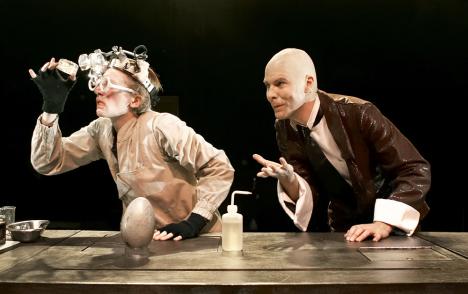Dr Egg and the Man with No Ear: visual flair

On the night I saw Dr Egg and the Man with No Ear the audience was resolutely adult. This is a shame because this Australian production, which was re-staged recently in Chicago and is currently on at the Cultch, would be a great introduction for young people to the power of theatre to create beautiful and evocative imagery. The visual flair that the production exhibits – which ranges from crisp projections (animated by Jamie Clennett) through to puppets (built by Graeme Davis) to the clever set and costume (designed by Jonathon Oxlade), all supported by a wonderful musical score (by Lara Golan) – is impressive and makes Dr Egg worth seeing in its own right. Unfortunately, the narrative underpinning the visuals is not nearly as sophisticated as the surface detail.
Co-created by Jessica Wilson (who directed) and Catherine Fargher (the writer), Dr Egg is, as advertised, a contemporary fairy-tale – complete with a “once upon a time” narrator (played with gusto by Tania Bozak). More correctly, it’s an update of the Frankenstein story and I’ll always happily sit through one of those. While taking his pregnant wife to the hospital, a man is attacked by a wild dog. His wife is killed but the baby survives. He also loses an ear. Although I don’t think this was the creators’ intent, the man seems more distressed about the loss of his ear than the loss of his wife. I’m afraid I found his self-pity a bit much, although Christian Bagin does fantastic, effecting clown work. Sometime later, his daughter, now a young woman (played by Rebecca Mauldin), decides to help her old man out by taking him to see Dr Egg (Adam Shalzi – perhaps the most youthful “Dr Frankenstein” I’ve ever seen, and all the more refreshing because of it). This Dr Egg claims he can grow a new ear in his laboratory – although there are potential complications that could arise. Upon seeing the Faustian contract that he has to sign before the procedure can take place (and which will protect the doctor), the man refuses to undergo the procedure but the daughter returns later and surrenders a piece of her own DNA. From this DNA a monstrous fish-baby is created.
Although the creators claim that Dr Egg is designed to ask questions about the wisdom of genetic research, the central message of the work is pretty clear in that this form of scientific exploration is ultimately unwise. Now, I’m totally onboard with stories that explore the hubris of humans, particularly when it comes to notions of our relationship with nature but for my money the production didn’t really raise questions about genetic research/modifications in any way that was new or unexpected (the “benefits” of genetic modification were demonstrated visually by a puppet mouse with an ear on his back and a batch of square tomatoes that the good doctor harvests). The show does end with a potent question: what to do with the misbegotten creations of such processes – but it provides no answers or real exploration of this question: it simply ends (in a smart, 60 minutes at that). For me that was a shame, as the fate of the fish-baby – with its strange doll-like face and disturbingly flappy tail – was far more compelling than the drama of the melancholic father.
Despite the limitations of story, the beauty of Dr Egg resides in the visual world that the production immerses the audience in; a world influenced by Tim Burton and Edward Gorey. There are many beautiful and haunting moments: the father sitting alone in the house watching television, the father bicycling through a city, the daughter swimming, the opening tableau of growing tree branches projected onto a scrim that covered the playing space. Perhaps most refreshing about this image-work is that none of it is rushed, the creators have the courage to keep the focus on these images so that a form of lyricism emerges that the audience can soak in. This is a wonderful evocation to the patience of older forms of storytelling and a nice corrective to the jump-cut worlds we usually have to suffer through.
The performers switch between clown work and puppet work effortlessly. I confess that I wasn’t always sure why the decisions were made for which sequences should be conveyed by performer directly and which should be done through puppets, although I suspect that the decision was usually informed by the demands of the visual ideals rather than thematic ones. There was one exciting moment where the visual and thematic came together beautifully. At the top of show the narrator produces the characters from underneath a massive skirt – a simple evocation of the birthing process. This subtly alluded to the creative process that the show explores. I could have done with more moments like this, ones that made the narrative structure beneath the exhilarating visual surface more substantial.
Dr Egg and the Man with No Ear is on at the Cultch until November 6. For more information go here.



